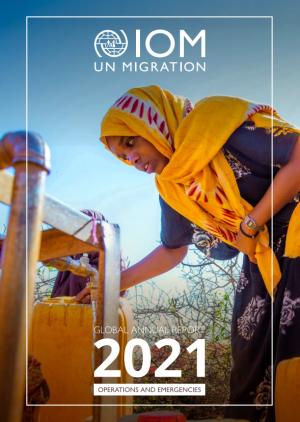In 2021, the organization’s work on the mobility dimensions of crisis had an operational reach of over 31.7 million people, including internally displaced persons (IDPs), refugees, migrants, and hosting communities, either directly or as part of community-based programmes. While IOM experienced a lower overall reach than in 2020, the organization’s reach in 2021 was similar to that of pre-pandemic years, with COVID-19 prevention, mitigation, and responses mainstreamed into normal programming.
IOM remained a leading actor in life-saving emergency responses and actively engaged in the humanitarian coordination system. In 2021, the organization held a coordination role in 142 coordination structures taking the form of clusters, working groups (WGs), sectors, platforms, and taskforces. At the field level, with direct data collection coordinated through the organization’s Displacement Tracking Matrix (DTM), IOM served as a primary source of objective and impartial data on displacement. DTM informed over 84 per cent of humanitarian needs overviews (HNOs) and humanitarian response plans (HRPs) in 2021, paving the way for stronger partnerships and more timely, efficient, and targeted responses.
With the aim of ensuring resilience and sustainability, IOM supported a wide array of programmes inclusive of humanitarian, transition, and recovery programming, as well as resettlement and humanitarian return operations. In 2021, IOM implemented cash-based interventions through activities in 119 countries, reaching nearly 1.9 million beneficiaries, while Camp Coordination and Camp Management (CCCM) operations reached over 3.9 million people living in 1,561 displacement sites across 35 countries, a slight increase in reach as compared to 2020. The organization simultaneously enacted transition and recovery (TR) projects across 87 countries, reaching over 5.3 million beneficiaries and demonstrating the Humanitarian-Development-Peace Nexus (HPDN) in action. IOM’s mandate and experience in direct implementation continued to give the organization a unique comparative advantage in 2021.
IOM’s work in preparedness, disaster risk reduction (DRR), and resilience helped prepare states and communities for and minimized the impacts of crises. With an extensive operational footprint in fragile contexts, IOM continued to develop interventions in line with the HDPN, a participatory approach that prioritizes understanding local contexts, involvement of diverse stakeholders, and the building of sustainable and inclusive partnerships. As part of its overall approach, IOM prepared the ground for the progressive resolution of displacement, as well as for longer-term transition and recovery, at the start of crises, wherever possible. Its presence throughout all phases of crises fostered trust and long-lasting relationships with populations, authorities, and communities, resulting in holistic and localized approaches in support of national and local authorities.
This report provides a snapshot of IOM’s crisis-related activities in the areas of emergency preparedness and response (PR), through TR, resettlement, and movement management (RMM). The report is based on the inputs collected through the organization’s yearly reporting exercises and outlines areas of significant achievement as well as opportunities for future growth and scale-up within the humanitarian system.
